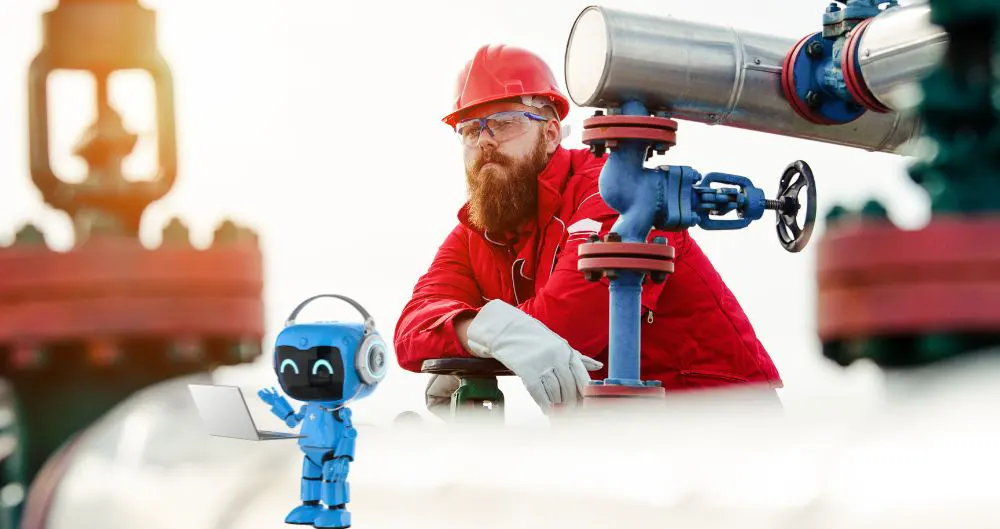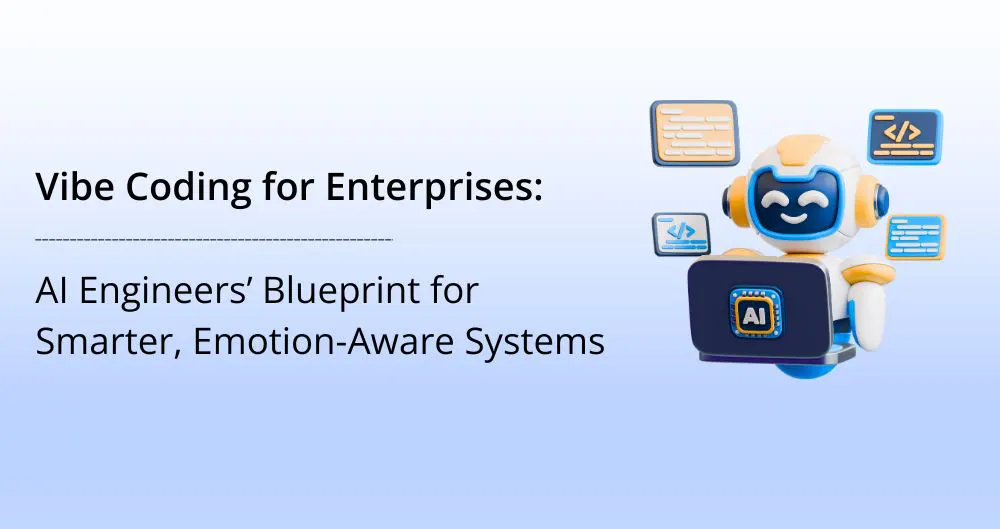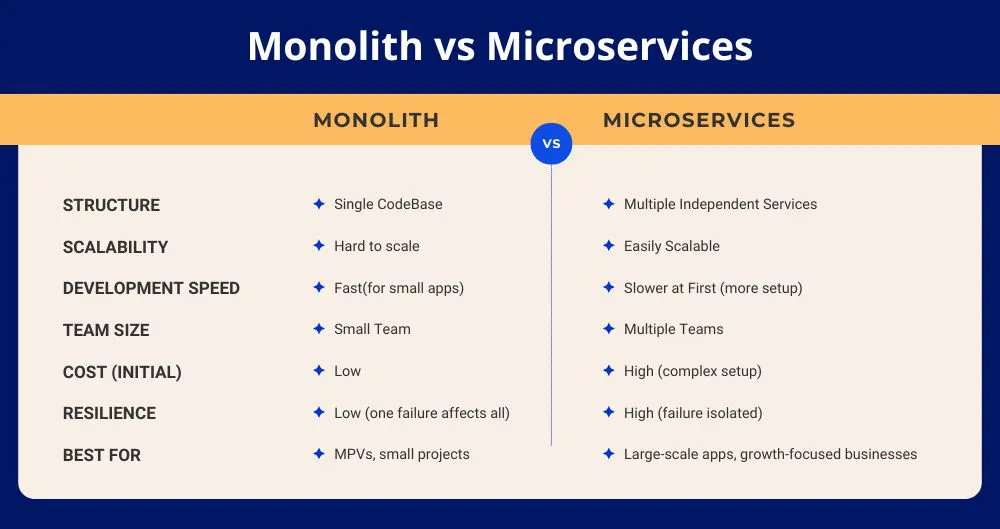April 15, 2025
The oil and gas (O&G) industry has traditionally prioritized caution and established practices over rapid innovation. But as the landscape evolves, a key question arises: Is there a place for artificial intelligence in oil and gas?
Many industry leaders are already turning to AI to tackle long-standing organizational challenges — and the appeal is clear. From early exploration through to final distribution, AI has the potential to optimize operations, reduce costs, and enhance safety across the board.
So, how exactly is AI accelerating growth for O&G companies?

AI in the Oil and Gas Industry: How It Helps
Different types of AI are making it easier to use data in the oil and gas industry:
- Machine Learning (ML): This analyzes data to find patterns and predict outcomes, helping to improve tasks like reservoir exploration, drilling, and fault detection.
- Deep Learning: A more advanced version of ML, deep learning uses complex networks to analyze data more deeply, like performing detailed seismic analysis to uncover hidden insights.
- Generative AI: This AI learns from existing data and can create new data samples, emergency instructions, or summaries.
- Natural Language Processing (NLP) & Computer Vision: These technologies help interpret human language and visual data, which is useful for tasks like generating reports and checking quality.
- Edge AI: This AI processes data directly on devices, without needing internet or cloud storage. It’s useful for adjusting machinery, tracking sensors, collecting seismic data, and monitoring safety remotely.
How AI Transforms the Oil and Gas Industry at Every Stage
AI is changing every part of the oil and gas supply chain, helping companies improve efficiency and move closer to sustainability and net-zero goals.
Predicting the Location, Quality, and Size of Reservoirs
Reservoir engineers sift through lots of seismic and electromagnetic data to find new oil and gas deposits. Traditional exploration is costly, risky, and prone to errors since it depends heavily on human fieldwork. Drilling dry wells is expensive and wastes resources — the investment in geological assessments, drilling, and testing is lost if the well doesn’t produce.
AI helps reduce these costly mistakes in exploration. Here’s how:
- Better Seismic Image Interpretation: AI can enhance poor-quality seismic images, removing noise, improving resolution, and detecting subtle features that would otherwise be missed.
- Improved Reservoir Understanding: Generative AI analyzes geological maps, production data, and well logs to create models of reservoirs. These models help engineers predict fluid movement and the well’s performance over time.
- Smarter Well Placement: IoT devices and edge computing process real-time sensor data locally, such as pressure, temperature, and flow rates, without relying on external systems. This reduces the time to create geological models for well placement from months to hours, according to Deloitte.
Increasing Extraction Rates with Automated Drilling
With high costs, oil and gas companies aim to get drilling right the first time. AI-driven drilling optimization helps achieve this goal.
Predictive intelligence helps engineers turn historical and real-time data into actionable insights for better drilling preparation. Using advanced machine learning, geosteering teams analyze large amounts of past data to set the best parameters, like weight on bit, drilling speed, and angle. AI-powered neural networks also predict issues like stuck pipe events, allowing teams to take action early.
The result? AI reduces the risk of drill-bit failures and boosts extraction rates.
Early Detection and Prevention of Equipment Failures
Oil and gas companies spend a lot of time managing equipment and scheduling maintenance.
Manual monitoring can be slow, prone to errors, and doesn’t fully utilize historical data. AI-powered fault detection solves this by spotting patterns, predicting failures, and improving operations.
Drones and robots with tiny sensors and cameras inspect equipment with precision. AI models can detect cracks, corrosion, and other signs of wear. This allows for 24/7 inspections without human intervention, lowering risks and reducing costs.
Providing Field Workers with AI Assistants
Exploration often involves high pressures, extreme heat, flammable substances, and other hazards, leading to numerous tragic safety incidents. Virtual field assistants now provide drilling crews, well operators, and technicians with fast and easy access to vital information. These conversational AI assistants can be seamlessly integrated into field-friendly devices, ensuring 24/7 availability and proving more efficient in emergencies than human-run call centers.
“
A great example of AI-driven asset maintenance is seen at Shell. They use a machine learning-based predictive analytics solution to prevent critical equipment failures and pinpoint when maintenance is required. This allows their staff to focus more on engineering tasks rather than sifting through vast amounts of data, while also helping the company cut down on production losses and maintenance costs.
— Shehzad Ali, AI Lead Engineer, Techzooni
Impact of AI on Oil and Gas
Here’s a collection of all the analyzed use cases, showcasing the impact AI solutions have on various tasks performed by oil and gas professionals.
| Segment | Operations | Impact | Technologies involved |
| Upstream | Reservoir exploration | – targeted wells placements – reduced environmental footprint – extended oil field lifecycle |
Neural networks, machine learning algorithms, edge AI, generative AI |
| Drilling automation | – minimized drilling costs – increased extraction rates |
Predictive analytics and decision trees, digital twins, machine learning | |
| Automated fault detection | – extended equipment lifetime – minimized disruptions – reduced expenses – automated maintenance scheduling |
Computer vision and convolutional neural networks | |
| Field workers’ support | – reduced costs – 24/7 availability – enhanced safety |
NLP, generative AI | |
| Midstream | Storage facilities inspection | – accelerated detection – automated safety measures |
Computer vision, edge AI, generative AI |
| Routes planning | – reduced delivery delays – lower fuel usage – enhanced safety |
Optimization algorithms, ML | |
| Downstream | Refinery optimization | – increased output – minimized energy consumption – enhanced safety |
AI-powered monitoring systems, IoT & smart sensors |
| Quality control | – accelerated compliance – minimized waste |
ML algorithms, predictive models, IoT & smart sensors | |
| Product R&D | – reduced experiment consumables – minimized guesswork – greater scope for experimentation |
Generative AI | |
| Cross-stream | Asset maintenance planning | – extended equipment lifetime – minimized disruptions – reduced expenses – automated maintenance scheduling |
Edge AI, predictive algorithms, generative AI |
| Supply chain optimization | – reduced delivery delays – lower fuel usage – automated risk mitigation |
Optimization algorithms, digital twins, generative AI |
3 Steps to Start Your AI Project in the Oil and Gas Sector
Don’t let challenges hold you back. According to McKinsey, to create value beyond 2030 and balance sustainability, affordability, and supply security, oil and gas companies must address several key questions, including:
-
How can new technologies and AI be scaled to deliver real business value?
So, how can oil and gas executives begin to achieve the benefits of AI?
1. Tackle Data Issues
High-quality data is crucial for successfully adopting AI.
What can you do?
-
Identify all raw data sources (e.g., equipment, sensors, satellite imagery).
-
Review how you collect and store data, such as geological data or historical maintenance records.
-
Strengthen your data science and big data capabilities to ensure security and quality.
2. Identify Use Cases
AI can be powerful, but it’s not a magic fix for every process. Forget about the idea of a one-size-fits-all solution.
Instead, focus on areas that handle large amounts of data and directly impact revenue, costs, or risk management.
By improving small, manageable processes, you’ll create opportunities for larger AI initiatives.
— Shehzad Ali, AI Lead Engineer, Techzooni
3. Create a Deployment Strategy
While deployment varies by sector, these five criteria are essential:
-
Perform a cost-benefit analysis
-
Consider the impact on people and operations
-
Develop a responsible implementation framework
-
Ensure data integrity
-
Establish effective governance
These factors will help you create a successful deployment strategy that fosters business growth and supports sustainability.
Frequently Asked Questions
1. How is AI used in oil and gas?
2. How generative AI is used in oil and gas?
3. Which oil companies are using AI?
Table of Contents
- AI in the Oil and Gas Industry: How It Helps
- How AI Transforms the Oil and Gas Industry at Every Stage
- Impact of AI on Oil and Gas
- 3 Steps to Start Your AI Project in the Oil and Gas Sector
- Frequently Asked Questions
- Related Articles
- Vibe Coding for Enterprises: AI Engineers’ Blueprint for Smarter, Emotion-Aware Systems
- Microservices vs Monolith: Which Architecture is Right for Your Project?
- Avoiding Pitfalls: Why Enterprise Projects Fail and How to Stop It

Why Trust Techzooni?
🤖 Proven Expertise in AI Development
🔒 Secure and Scalable Solutions
🌐 End-to-End Support from Concept to Execution
📈 Data-Driven Decisions for Better Business Outcomes
With Techzooni, you can trust that your AI initiatives will be handled with care, precision, and innovation.
Related Articles
Vibe Coding for Enterprises: AI Engineers’ Blueprint for Smarter, Emotion-Aware Systems
Imagine a future where building software feels a bit like having a conversation. You tell your system what you want in plain English. Behind the scenes, intelligent agents spin up code, run tests, refactor, and even suggest improvements. That’s the world of vibe...
Microservices vs Monolith: Which Architecture is Right for Your Project?
Imagine that you’re opening a new restaurant. You could either rent one big hall where the kitchen, storage, and dining all happen in the same space—or you could design separate sections: a kitchen, a pantry, a dining area, and a drive-thru. Both setups can serve...
Avoiding Pitfalls: Why Enterprise Projects Fail and How to Stop It
Every successful software project starts with one key step: understanding why so many others fail. Large-scale enterprise initiatives are ambitious, but they often run into hurdles that derail progress. Research from Deloitte shows just how common this is. Among...



